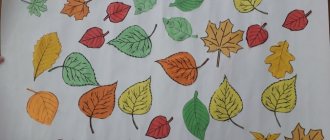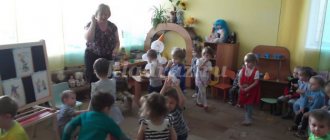Thematic planning “Theater Week” in the preparatory school group
Thematic planning “Theater Week” in the preparatory school group
Goal: Development of children's abilities through theatrical art.
Objectives: Create conditions for the development of creative activity of children participating in theatrical activities. To improve children's artistic skills in terms of experiencing and embodying the image, as well as their performing skills. Teach children the elements of artistic and figurative means of expression (intonation, facial expressions, pantomime). Activate children's vocabulary, improve the sound culture of speech, intonation structure, and dialogic speech. To develop experience in social behavior skills and create conditions for the development of children’s creative activity. Introduce children to various types of theater (puppet, musical, children's, animal theater, etc.). To develop children's interest in theatrical play activities
Classes are designed for children of senior preschool age (6-7 years old).
Working with parents:
• Visual propaganda about holding a theater week in a preschool educational institution.
• Conversations with parents on the topic of the week.
• Visual information “The importance of theatrical activities in the life of a preschooler”
| date | Time periods of the day | Joint activity of teacher and child | Independent activity | Cooperation with family (social partners) | |
| Organization of children's activities | Forms of organization | Organization development environment | |||
| Monday Monday | Morning | 1.Cognitive | Conversation with children “We came to the theater” Introducing the concept of theater: (showing slides, paintings, photographs). Types of theaters (musical, puppet, dramatic, animal theater, etc.). Purpose: to give children an idea of the theater; expand knowledge of theater as an art form; introduce types of theaters; cultivate an emotionally positive attitude towards the theater. | Types of theaters (musical, puppet, dramatic, animal theater, etc.). Purpose: to give children an idea of the theater; expand knowledge of theater as an art form; introduce types of theaters; cultivate an emotionally positive attitude towards the theater. Plot-role-playing game “We came to the theater.” | Invite parents to talk with children about theatrical professions (artist, make-up artist, hairdresser, musician, decorator, costume designer, actor). Goal: to form children’s ideas about theatrical professions; to intensify interest in theatrical art; Expand words knowledge. |
| OOD | Social - communicative 2. Artistic and aesthetic | “We played and danced” - an imitation of accompanying nursery rhymes on children's musical instruments. Improvisation on a theme with sounding movements Song improvisation | |||
| Walk | Cognitive and research Game motor | Walk No. 1 See the card index for September. Outdoor game “We are funny guys.” | |||
| Evening Communicative; Constructive; Motor; Gaming; Perception of fiction. | Plot-role-playing game “We came to the theater.” Purpose: to introduce the rules of behavior in the theater; arouse interest and desire to play (play the role of “cashier”, “ticketer”, “spectator”); cultivate friendly relationships. 2. Conversation about the rules of conduct in the Spectator Culture theater. Goal: To give children an idea of the rules of conduct in public places; to form a personal attitude towards non-compliance and violation of rules. | ||||
| Independent activities of children | Gaming Communication | Free games for children Learning finger gymnastics | Add a card index of dynamic pauses and breathing exercises on a lexical topic. |
Contents of educational activities
| date | Time periods of the day | Joint activity of an adult and a child | Independent activity | Cooperation with family (social partners) | |
| Organization of children's activities | Forms of organization | Organization development environment | |||
| Tuesday | Morning | Social - communicative | “We are playing theater” - mimic gymnastics | Add a selection of illustrations and coloring pages. Add to the group a card index of designs for constructing from counting sticks. | Invite parents to play the game “Guess Who I Am?” with their children. |
| OOD | 1.Communicative | “We are future artists” - exercises for the development of expressive plasticity of movements, for the development of expressive facial expressions. “I’ll change myself, friends, guess who I am?” - dressing up in costumes, imitation sketches. Introduction to the fairy tale “The Bag of Apples” | |||
| Walk | Cognitive and research Game motor | Walk No. 2 See card index for September. Outdoor game "Falling Leaves". | |||
| Evening Communicative Constructive Motor Gaming | Plot-role-playing game “Let's play at the theater.” Finger theater “Ryaba Hen” (at the teacher’s choice). Goal: to develop children’s ability to use finger theater in free activities; distribute characters; convey the characteristic features of the heroes of the fairy tale. | ||||
| Independent activities of children | Gaming Communication | Free games for children: Making riddles. Goal: to teach children, when solving a riddle, to motivate their answer (this allows you to judge how children can compare a description with a real object or phenomenon), to develop auditory attention and logical thinking. | Add to the group a file cabinet of design schemes from building materials. |
Contents of educational activities
| date | Time periods of the day | Joint activity of an adult and a child | Independent activity | Cooperation with family (social partners) | |
| Organization of children's activities | Forms of organization | Organization development environment | |||
| Wednesday | Morning | Social - communicative | “It’s very difficult to live in the world without a girlfriend or boyfriend!” Reading a poem - “Say a kind word about a friend”, Performing the song “If you went on a journey with a friend”, music. V. Shainsky 2. Fairy tale “The Bag of Apples” - to develop the ability to follow the development of actions, to involve in the telling of a fairy tale, to convey the character and emotional state of the selected personnel, to arouse interest in what is happening, to intonationally and expressively convey the character of the selected personnel | Add a selection of books and illustrations Dramatization of a fairy tale by teachers | Invite parents to watch the cartoon with their child - the fairy tale Little Red Riding Hood, The Tsokotukha Fly, Fedorino's Grief, Kolobok, Teremok, Turnip, Bag of Apples discuss what you saw |
| OOD | 1.Cognitive 2.Motor | Teacher’s story “The history of the creation of the puppet theater” Physical development indoors (mastery of basic motor skills, performing movements according to a pattern). | |||
| Walk | Cognitive and research Game motor | Walk No. 3 See card index for September. Outdoor game "Sparrows and a car." Goal: to teach children to run in different directions without bumping into each other, to start moving and change it at the teacher’s signal, to find their place. | |||
| Evening | Communicative Constructive Motor Game Perception of fiction | Children's games with sounding instruments. Goal: to give children an idea of the musical design of performances. An evening of riddles based on the works “Little Red Riding Hood”, “Tsokotukha the Fly”, “Fedorino’s Grief”, “Kolobok”, “Teremok”, “Turnip”. S/r game “A trip to the puppet theater”. Purpose: To acquaint children with the structure of the theater building, to draw attention to the originality of the architecture and the beautiful facade. Enrich children's vocabulary. Free games. | |||
| Independent activities of children | Artistic and aesthetic Communication | Individual work on speech development, game “Say the other way around.” Dima and Polina. Goal: Replenishment of active vocabulary. Making paper crafts according to patterns. | Add to the group diagrams for making paper crafts on a lexical topic. |
Contents of educational activities
| Thursday Friday | Time periods of the day | Joint activity of an adult and a child | Independent activity | Cooperation with family (social partners) |
| Organization of children's activities | Forms of organization | Organization development environment | ||
| OOD | 1. Artistically aesthetic 2. Artistic and aesthetic | Theatrical game “Circus of Animals” - consolidating the elements of acting, memory, and imagination in the game. Conversation with children “The World of Circus”, “The famous artist Yuri Nikulin”. I'll draw my favorite animal Discussion of roles in the fairy tale “The Bag of Apples”, distribution of roles Music according to the music director's plan. | Add a selection of illustrations depicting animals exhibition of drawings | Offer parents and their child creative games: “Good - bad” - the rules of behavior in the theater, the players portray using facial expressions and pantomime. Game “Animals in the Zoo”, game “Animal Voices” |
| Walk | Cognitive and research Game motor | Walk No. 4 See card index for September. Improvisation game “Inflate, my balloon.” | ||
| Evening Communicative Motor Game Perception of fiction | Psycho-gymnastics. "Different faces." Goal: Encourage children to experiment with their appearance (facial expressions, gestures). Develop children's ability to switch from one image to another. Showing the fairy tale “Zayushkina’s Hut” (at the teacher’s choice). After the show, invite the children to try to play with the fairy tale characters on their own using toys. Goal: introducing children to theatrical art. | |||
| Independent activities of children | Artistic and aesthetic Communication | Independent activity of children in the theater corner. Looking at bi-ba-bo dolls with children. A conversation about how to properly use dolls, which is a tool for driving bi-ba-bo dolls. Goal: Improve puppeteering techniques, consolidate knowledge about the rules for manipulating theatrical puppets of different systems. | Add puppet theater to the group. |
Contents of educational activities
| date | Time periods of the day | Joint activity of an adult and a child | Independent activity | Cooperation with family (social partners) | |
| Organization of children's activities | Forms of organization | Organization development environment | |||
| Friday | Morning | Social - communicative | Introduction to musical theaters. Purpose: To give an idea of the various genres of musical theater, such as “opera”, “ballet”, “musical fairy tale”. Rehearsal of the play “Sack of Apples” | Add to group s.-r. games. Audio recording of opera melody, musical fairy tales | Performance of the play “Sack of Apples” for parents and children |
| OOD | 1.Cognitive 2.Motor | Drawing. Making a poster for the play “Sack of Apples”, group work Physical education on the street. | |||
| Walk | Cognitive and research Game motor | Walk No. 5 See card index for September. Outdoor game “Along a narrow path.” | |||
| Evening | Communicative Motor Game Perception of fiction. | Musical folk and round dance games according to the age of children. Goal: Encourage children to actively participate in games. | |||
| Independent activities of children | Artistic and aesthetic Communication | Rhythmoplasty. Sketches for movement: “The Fox is Coming”, “Dance of the Animals”. Goal: To develop children's ability to use gestures. Voice-over of a fairy tale chosen by children using noise instruments. Encourage children to creatively interpret famous stories using noise instruments | Add noise instruments to the group |
Get text
Materials for organizing a thematic week
When introducing children to the theater, they will need decorations and toys available directly at the preschool educational institution.
Each kindergarten has a small theater corner, where children begin their acquaintance with the world of art. During the theater week the following materials are used:
- rag dolls, table theater;
- flannelograph, on which small works are staged in order to develop expressive speech;
- cardboard decorations;
- books for reading fairy tales and assigning roles;
- costumes;
- baby books, toys;
- decoration materials: cardboard, paper, glue, scissors;
- ready-made suits.
Work on theatrical activities in a preschool institution is carried out according to a specific scheme approved by the Federal State Educational Standard. Children first become spectators of the play themselves, express their opinions about the production, and then begin to prepare their performance.
Decorations for the production
To better recreate the atmosphere of the holiday and the theater, the teacher plays various games with the children: “guess the name of the hero”, “portray your favorite fairy tale hero”, “remember and tell”.
Theater week in kindergarten
Theater is one of the brightest, most colorful and accessible spheres of art for a preschooler. It develops imagination and fantasy, promotes the creative development of children, helps to relax, develops communication skills, increases self-esteem, develops speech, the emotional sphere and simply brings bright, unforgettable variety to everyday life, enriching the child’s inner world.
On March 27, the whole world celebrated the great art, whose name is THEATER. From March 28 to April 1, our kindergarten “lived” with the theater; the traditional “Theater Week” was held for preschoolers.
Children and teachers of younger groups (building No. 1) presented to the audience the fairy tales “Ryaba the Hen” (group No. 1), “Snow Maiden and the Fox” (group No. 2), “Kolobok” (group No. 10), “Teremok” (group No. 11). Children and teachers of the middle groups were shown “Kolobok in a New Way” (group No. 12) and V. Suteev’s fairy tale “Under the Mushroom” (group No. 9).
Children of preparatory groups led by Shpilman N.A. presented the musical performance “The Tale of the Stupid Mouse”.
Young artists from building No. 2 also demonstrated their artistic abilities in front of their peers and children from other groups, presenting dramatizations of “Fly-Tsokotukha” and “Teremok” (middle groups), “Little Red Riding Hood” and “The Tale of the Stupid Mouse” (senior groups), “ Flint" and the puppet show "Kolobok" (preparatory groups).
When showing performances, a variety of scenery, costumes, screens, life-size and theatrical puppets were used. The children happily transformed into heroes of their favorite fairy tales, accompanying their performances with poetry, music and dance. For many of them, this was their first public performance.
The preschool audience warmly received the young talents and actively participated in the quiz based on the fairy tales. They rewarded the young artists with thunderous applause and called for an encore.
During the breaks between performances, the audience was delighted by the guys from the vocal ensemble “Sunny Bunnies” (building No. 2) with their performances.
Theatrical performances took place for several days. At the end of the “Theater Week” for children, the Tyumen Children’s Theater Theater performed the play “Reverse Laughter”, dedicated to the celebration of April 1 - April Fool's Day.
The entire “Theater Week” was accompanied by smiles and good mood, creating a cheerful emotional mood in the groups.
Everyone enjoyed seeing beautiful art!





